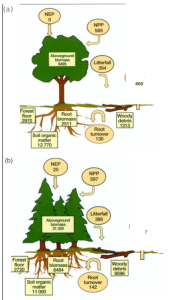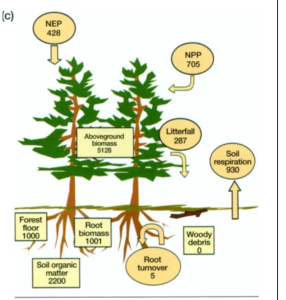1 Carbon Storage and Sequestration in Forest
Role of Carbon Storage; the Process that Forest Store; Suggestion and Stories on Carbon storage
Zitian Ni
The role of Carbon Storage and Carbon Sequestration
Carbon dioxide, which is served as one of primary greenhouse gas, occupies a major role on Earth biosphere. At the same time, Earth biosphere is an important part on global carbon budget. Carbon plays an essential role in people’s daily life. People need to breath, which means they need to absorb oxygen and release carbon dioxide. People need industry, there are lots of carbon dioxide will be released from differential kinds of industrial processes. Therefore, there is an increasingly interest in the storage of carbon. Carbon is stored in the forest ecosystem in the form of living tree biomass and dead organic matter. The most carbon is stored in the soil and in the living biomass, which we can call the carbon pool. For carbon pools, one needs to consider two questions: how much it contains, and how much it is changing, which people called carbon storage and carbon sequestration. “Carbon storage is the amount of carbon that is retained in a carbon pool within the forest, and carbon sequestration is the process of removing carbon from the atmosphere for use in photosynthesis, resulting in the maintenance and growth of plants and trees.” [1] Carbon plays an essential role in people’s daily life. People need to breath, which means they need to absorb oxygen and release carbon dioxide. People need industry, there are lots of carbon dioxide will be released from differential kinds of industrial processes. Therefore, there is an increasingly interest in the storage of carbon. Carbon is stored in forest ecosystems in the form of living tree biomass and dead organic matter. In most forests, the largest C pools are aboveground live biomass and mineral soil organic matter, with lesser amounts in roots and surface detritus.[2] For more detail on biomass, see the chapter Impacts of the ecological environment on biodiversity.

The process that forests store carbon
Before carbon storage can take place, forests need to capture carbon. In this world, trees can perform the most efficient and least costly carbon capture. This is because when trees photosynthesize, they absorb carbon dioxide from the air, which, when combined with the chemical reaction of sugar, eventually releases oxygen. After the carbon has been stored, the forest is ready for carbon capture. The older a tree is, the higher its carbon storage will be, and in most cases, the amount of carbon stored in trees will peak when they are two hundred years old. Although with current technology we cannot track the magnitude of changes in the soil carbon pool, we can infer the large amount of carbon based on the amount of organic matter in the soil.
Carbon in soils undergoes a variety of complex reactions with organic matter, the magnitude and direction of which depend on plant species, climate, and soil type. [3] Because water, air and sunlight are limited resources, trees with weak vitality will grow slowly because they cannot compete for good resources, especially when there are trees with large canopies around. Therefore we cannot predict the entire forest based on the condition of individual trees. In general, the warmer the climate and the longer the growing season, the more carbon the trees store, and interestingly, the less carbon is stored in the soil because the rate of decomposition is accelerated. But when some extreme conditions occur, such as tornadoes, heavy rains, pests, diseases, and droughts, carbon emissions increase significantly, which means that carbon storage decreases significantly. When vegetation cover is large, carbon is more likely to be collected and stored. This is because even though the chemical reactions between plants will not be more intense, the overall base is larger, so the amount of carbon becomes more abundant.

 In some forests, like in Canada by the tundra, the soil holds more carbon than the trees, but in other forests, like the rain forest, the soil holds relatively little carbon and the trees store more carbon. [4] Also, like everything, carbon in forests will eventually disappear because the molecules are active and they break down, react with other compounds, and are released into the atmosphere.
In some forests, like in Canada by the tundra, the soil holds more carbon than the trees, but in other forests, like the rain forest, the soil holds relatively little carbon and the trees store more carbon. [4] Also, like everything, carbon in forests will eventually disappear because the molecules are active and they break down, react with other compounds, and are released into the atmosphere.
Suggestions on carbon storage
The first suggestion for the carbon cycle is to discover the lowest and most environmentally friendly way to store carbon. Because in today’s world, we cannot live without carbon, especially in industry and in our lives.
The second suggestion is that accelerate pre-competitive exploration and assessment of CO2 storage facilities in key regions to ensure future availability of storage. Because if one is developing and evaluating carbon pools, some precise reconnaissance can help one get the most amount of carbon in the shortest amount of time.
The third recommendation is to continue to develop the practicality and increase the cost competitiveness of carbon elements, for example CO2 use, electrolytic hydrogen and synthetic hydro-carbon fuels produced from hydrogen. [5]
The last suggestion is to increase the protection of forests. Because as I mentioned in my second paragraph, forests control the most carbon, even though trees of different ages will have different levels of carbon absorption. (For more details, see the (Yanxin Wang and Xiangying Wang) Logging in Relation to Forests in the first chapter)
- Catanzaro, Paul, and Anthony D’Amato. “Forest Carbon - Masswoods.” Masswoods, 2019, https://masswoods.org/sites/masswoods.org/files/Forest-Carbon-web_1.pdf. ↵
- https://esajournals.onlinelibrary.wiley.com/doi/abs/10.1890/080169 ↵
- Fahey, Timothy J., et al. “Forest Carbon Storage: Ecology, Management, and Policy.” Frontiers in Ecology and the Environment, vol. 8, no. 5, 2010, pp. 245–52. JSTOR, http://www.jstor.org/stable/27809111. Accessed 2 Dec. 2022. ↵
- Norman, Calvin, and Melissa Kreye. “How Forests Store Carbon.” Penn State Extension, 24 Sept. 2020, https://extension.psu.edu/how-forests-store-carbon. ↵
- IEA (2019), The Role of CO2 Storage, IEA, Paris https://www.iea.org/reports/the-role-of-co2-storage, License: CC BY 4.0 ↵

